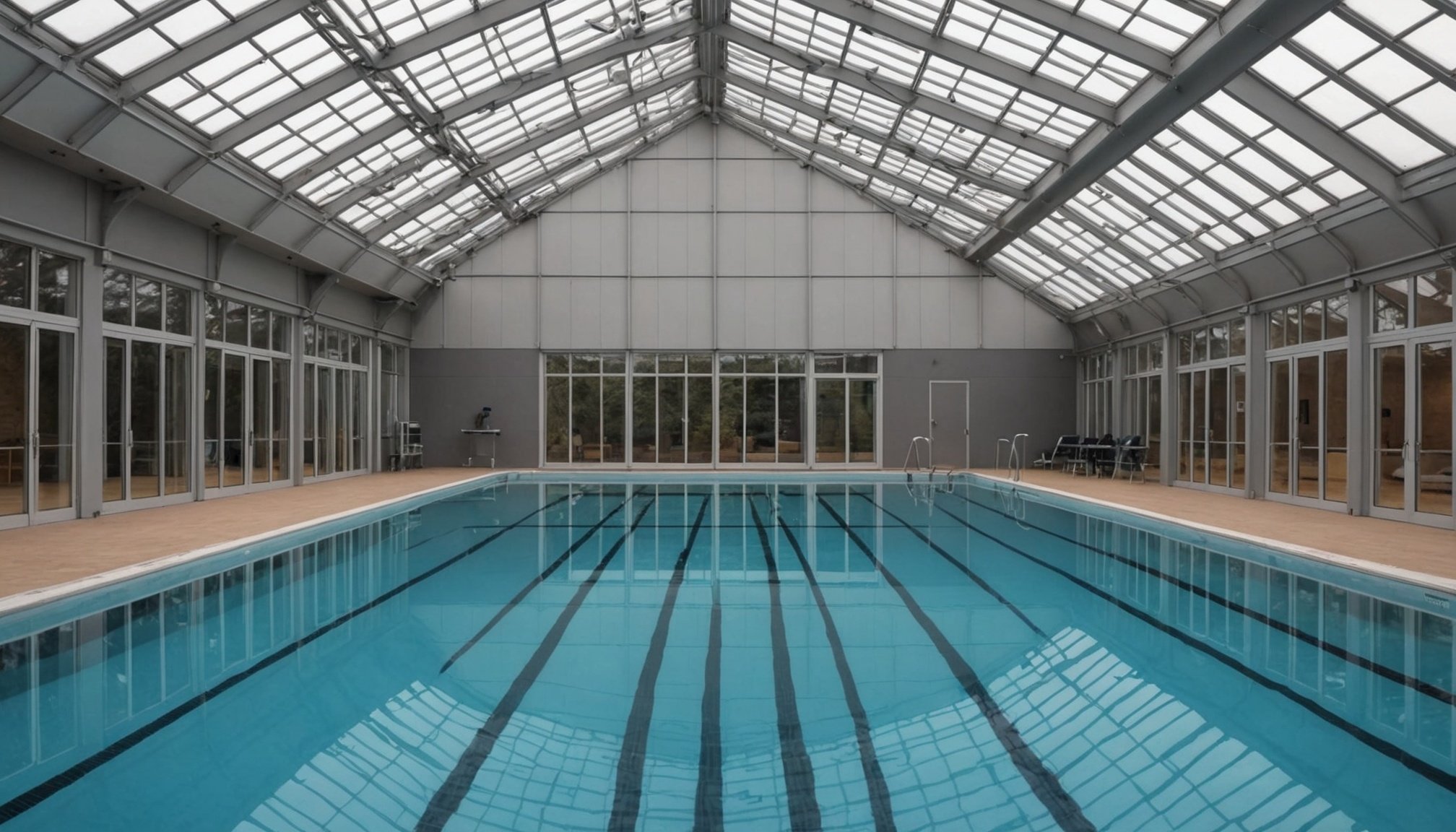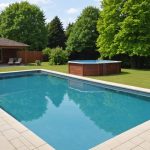Maximize Energy Efficiency: Top Budget-Friendly Insulation Strategies for Indoor Swimming Pools in the UK
When it comes to maintaining an indoor swimming pool in the UK, one of the most significant challenges is managing energy costs. Heating a pool can be expensive, but there are several budget-friendly insulation strategies that can help you maximize energy efficiency and keep your pool warm without breaking the bank.
Understanding the Importance of Insulation
Insulation is crucial for any swimming pool, especially in a cooler climate like the UK. It helps in reducing heat loss, which in turn lowers your energy costs and makes your pool more energy efficient.
Cela peut vous intéresser : Discover the Health Benefits of Having a Swimming Pool in the UK: A Dive into Wellness!
Heat Loss and Its Impact
Heat loss from a swimming pool can occur through several pathways: the water surface, the pool walls, and the floor. Here’s a breakdown of how each contributes to overall heat loss:
- Surface Heat Loss: This is one of the most significant sources of heat loss. The surface of the pool water is directly exposed to the air, leading to evaporation and heat loss.
- Wall and Floor Heat Loss: If the walls and floor of your pool are not properly insulated, heat can escape through these areas as well.
To mitigate these losses, effective insulation strategies are essential.
A lire également : Essential Factors to Consider When Installing a Counter-Current Swimming Pool System in the UK
Pool Enclosures: A Comprehensive Solution
One of the most effective ways to insulate your indoor swimming pool is by using a pool enclosure. Here’s why:
Benefits of Pool Enclosures
Pool enclosures are more than just a decorative addition; they offer several practical benefits:
- Reduce Evaporation: By covering the pool, enclosures significantly reduce water evaporation, which is a major source of heat loss. For example, a 32 m² pool can lose up to 40 liters of water per day through evaporation, which also means losing heat[5].
- Retain Heat: Enclosures act as a barrier between the pool water and the cooler air, helping to retain the heat in the pool.
- Protect from Debris: They keep the pool clean by preventing leaves, insects, and other debris from entering the water.
- Enhance Safety: Many pool enclosures serve as effective child safety devices, providing an added layer of protection for families with young children.
Types of Pool Enclosures
There are several types of pool enclosures available, each with its own set of advantages:
- Telescopic Swimming Pool Enclosures: These are customisable and can fit seamlessly with your pool. They offer unparalleled versatility and protection against the elements[5].
- Retractable Pool Enclosure Boxed Kits: These are convenient and easy to install. They provide the flexibility of opening up your pool space on sunny days and providing shelter during inclement weather[5].
Solar Panels and Solar Heating
Solar energy is a renewable and eco-friendly way to heat your swimming pool. Here’s how you can leverage solar power:
How Solar Heating Works
Solar heating systems use solar panels to capture the sun’s energy and transfer it to your pool water. Here are some key points to consider:
- Cost-Effective: While the initial installation cost of solar panels can be high, they offer long-term savings on energy costs.
- Eco-Friendly: Solar energy is a clean and renewable source of energy, making it an environmentally friendly option.
- Durability: Solar panels are durable and can last for up to 25 years or more.
Installing Solar Panels
When installing solar panels for your pool, consider the following:
- Orientation and Placement: Ensure that the solar panels are placed in an area that receives maximum sunlight.
- Size and Number of Panels: The number and size of the panels will depend on the size of your pool and your heating needs.
Here is a rough estimate of the costs involved in installing solar panels for pool heating:
| Component | Estimated Cost |
|---|---|
| Solar Panels | £3,000 – £6,000 |
| Pump and Controls | £1,000 – £2,000 |
| Installation | £1,500 – £3,000 |
| Total | £5,500 – £11,000 |
Heat Pumps: An Energy-Efficient Alternative
Heat pumps are another energy-efficient way to heat your swimming pool. Here’s why they are a good option:
How Heat Pumps Work
Heat pumps work by extracting heat from the air and transferring it to your pool water. Here are some benefits:
- Energy Efficiency: Heat pumps can be up to 4-6 times more energy-efficient than traditional gas or electric heaters.
- Cost-Effective: While the initial cost of a heat pump can be higher, it offers significant long-term savings on energy costs.
- Low Maintenance: Heat pumps require less maintenance compared to other heating systems.
Types of Heat Pumps
There are several types of heat pumps available:
- Air-Source Heat Pumps: These are the most common type and work by extracting heat from the air.
- Ground-Source Heat Pumps: These are more expensive but can be even more efficient as they extract heat from the ground.
Here is a comparison of the costs involved in using different types of heat pumps:
| Type of Heat Pump | Initial Cost | Operating Cost | Efficiency |
|---|---|---|---|
| Air-Source Heat Pump | £3,000 – £6,000 | £500 – £1,000/year | 4-6 times more efficient than traditional heaters |
| Ground-Source Heat Pump | £8,000 – £12,000 | £300 – £600/year | 5-7 times more efficient than traditional heaters |
Spray Foam Insulation for Pool Areas
Spray foam insulation is a highly effective method for insulating the areas around your swimming pool, including the walls and floor.
Benefits of Spray Foam Insulation
- High Thermal Resistance: Spray foam has a high thermal resistance, meaning it can effectively reduce heat loss.
- Durability: It is durable and can last for many years without needing replacement.
- Moisture Resistance: Spray foam is resistant to moisture, which is crucial in a pool environment.
Here are some steps to consider when using spray foam insulation:
- Professional Installation: It is recommended to hire a professional for the installation to ensure it is done correctly.
- Safety Precautions: Ensure that the area is well-ventilated and that safety gear is worn during the installation process.
Practical Tips for Maximizing Energy Efficiency
Here are some practical tips to help you maximize energy efficiency for your indoor swimming pool:
Regular Maintenance
- Regularly clean the pool and its surroundings to ensure optimal performance of the heating system.
- Check the pool enclosure and ensure it is in good condition to prevent heat loss.
Optimize Pool Temperature
- Maintain a consistent pool temperature. A temperature range of 26 to 31 degrees Celsius is ideal for most swimming activities[4].
Use Energy-Efficient Systems
- Consider using energy-efficient systems such as heat pumps and solar panels.
- Ensure that your pool pump and lighting system are energy-efficient.
Insulate the Pool Area
- Insulate the walls and floor of the pool area using spray foam or other insulation materials.
- Use pool covers when the pool is not in use to reduce evaporation and heat loss.
Maintaining an indoor swimming pool in the UK can be energy-intensive, but with the right insulation strategies, you can significantly reduce your energy costs. Here are some key takeaways:
- Use Pool Enclosures: They reduce evaporation, retain heat, and protect the pool from debris.
- Leverage Solar Energy: Solar panels offer a cost-effective and eco-friendly way to heat your pool.
- Install Heat Pumps: Heat pumps are energy-efficient and can provide long-term savings.
- Insulate the Pool Area: Spray foam insulation can effectively reduce heat loss from the pool walls and floor.
By implementing these strategies, you can enjoy your indoor swimming pool while keeping your energy costs under control.
Detailed Bullet Point List: Steps to Insulate Your Swimming Pool
Here is a detailed list of steps to help you insulate your swimming pool effectively:
- Assess Your Pool: Determine the size and type of your pool to decide on the best insulation strategy.
- Choose the Right Enclosure: Select a pool enclosure that fits your pool size and budget. Consider telescopic or retractable enclosures.
- Install Solar Panels: Determine the number and size of solar panels needed based on your pool size and heating requirements.
- Select a Heat Pump: Choose between air-source and ground-source heat pumps based on your budget and efficiency needs.
- Apply Spray Foam Insulation: Hire a professional to apply spray foam insulation to the walls and floor of the pool area.
- Regular Maintenance: Regularly clean the pool and check the condition of the enclosure and insulation to ensure optimal performance.
- Optimize Pool Temperature: Maintain a consistent pool temperature to reduce energy consumption.
- Use Energy-Efficient Systems: Ensure that your pool pump and lighting system are energy-efficient.
- Use Pool Covers: Use pool covers when the pool is not in use to reduce evaporation and heat loss.
Comprehensive Table: Comparison of Insulation Strategies
Here is a comprehensive table comparing different insulation strategies for your swimming pool:
| Insulation Strategy | Initial Cost | Operating Cost | Efficiency | Benefits |
|---|---|---|---|---|
| Pool Enclosures | £3,000 – £6,000 | £0 – £500/year | High | Reduces evaporation, retains heat, protects from debris |
| Solar Panels | £5,500 – £11,000 | £0 – £500/year | High | Eco-friendly, cost-effective, durable |
| Heat Pumps | £3,000 – £12,000 | £500 – £1,000/year | High | Energy-efficient, low maintenance, cost-effective |
| Spray Foam Insulation | £1,000 – £3,000 | £0 – £500/year | High | High thermal resistance, durable, moisture-resistant |
By understanding and implementing these insulation strategies, you can make your indoor swimming pool more energy-efficient and cost-effective.











